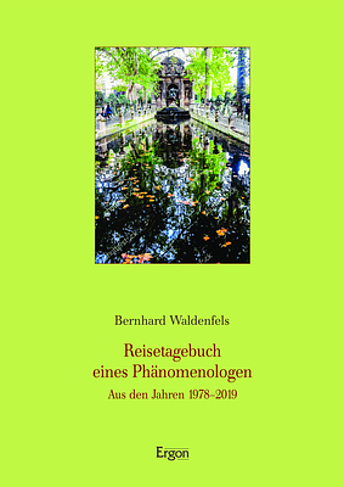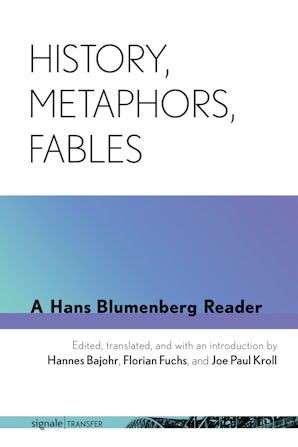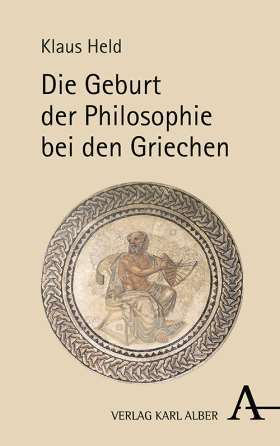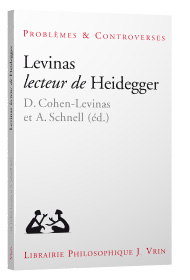 Comprendre Heidegger. L'espoir d'une autre conception de l'être
Comprendre Heidegger. L'espoir d'une autre conception de l'être
Bel Aujourd'hui
Hermann
2019
Paperback 28,00 €
292
Reviewed by: Karl Racette (Université de Montréal)
Publié une trentaine d’années après le très important livre Le tournant dans la pensée de Martin Heidegger (Épiméthée, 1987), Comprendre Heidegger. L’espoir d’une autre conception de l’être (Hermann Éditions, 2019) est la deuxième monographie de Jean Grondin portant exclusivement sur la pensée de Martin Heidegger. La publication de cet ouvrage aura précédé de peu La beauté de la métaphysique (Éditions du Cerf, 2019) publié le même été. La réception francophone de Heidegger aura été ainsi très comblée lors de la dernière année par ces deux ouvrages de J. Grondin qui, à plusieurs égards, pourront être lus de manière complémentaire.
Dès les premières lignes de l’ouvrage, l’A. affirme qu’il faut comprendre Heidegger d’abord et avant tout à partir de sa question essentielle, celle de l’être[1]. Cette exigence de compréhension apparaît prioritaire aux yeux de l’A. compte tenu de sa réception récente, qui s’est surtout concentrée sur l’engagement politique de Heidegger, prompte à discréditer d’emblée sa pensée. Comprendre Heidegger, nous dit J. Grondin, c’est à la fois comprendre son effort indéfectible de penser l’être, mais c’est aussi « comprendre sa personne et son engagement politique »[2]. L’approche de l’A. est au départ originale en ce qu’elle ne sépare pas l’homme de l’œuvre en vue de sauvegarder l’œuvre, mais tente plutôt de comprendre l’engagement politique de l’individu Heidegger à partir de la question qui anime l’œuvre, celle de penser à nouveau l’être.
C’est à cet effet que J. Grondin déploiera un double effort de compréhension – celui de la fusion des horizons, héritée de Gadamer et de transposition reprise de Schleiermacher – qui aura chacun l’œuvre et l’homme comme objet[3]. Nous pouvons dire que les chapitres 1 à 7 consistent en un effort de compréhension, se rapprochant de la fusion des horizons gadamérienne dans la mesure où les différentes interprétations proposées comportent toujours un moment de confrontation critique envers Heidegger. De leur côté, les chapitre 8 à 10 sont plutôt un effort de transposition dans l’horizon d’attentes de Heidegger où il s’agit de comprendre l’homme Heidegger selon ses projets, ses attentes, ses espoirs, etc. La visée de cette transposition étant surtout de comprendre les raisons personnelles qui ont poussé Heidegger à se reconnaître dans le national-socialisme. Ce double effort de compréhension possède néanmoins une visée commune : montrer que l’auteur et l’individu sont orientés par la même « étoile » qui guide toujours leur engagement spirituel et personnel, la question de l’être.
L’effort de compréhension de l’ouvrage est orienté par quatre présupposés de lecture que l’A. expose dès l’introduction. D’abord (1), il faut, comme nous l’avons dit, comprendre Heidegger (l’œuvre et l’homme) à partir de la question l’être : « Heidegger soutient à bon droit qu’elle est sa question essentielle, voire la seule question (au sens où tout dépend d’elle), mais aussi la question fondamentale de la pensée occidentale, voire de la pensée tout court, et qu’elle est tombée dans l’oubli dont il est opportun de la tirer »[4]. Si ce présupposer va de soi pour l’œuvre de Heidegger, cela semble être le pari de l’interprétation proposée par J. Grondin de la compréhension de l’homme Heidegger. Une bonne partie de l’ouvrage (en particulier les chapitres 8 à 10) cherche à montrer qu’il faut comprendre les raisons de l’engagement politique de Heidegger à partir des exigences théoriques et « pratiques » de sa propre philosophie. La motivation commune entre la pensée de l’auteur et son engagement politique réside dans le fait que (2) « notre conception de l’être reste dominée par une certaine intelligence de l’être qui est préparée de longue date, en vérité depuis les Grecs, mais qui est problématique et qui n’est peut-être pas la seule »[5]. Dans la perspective de Heidegger, nous explique l’A., il est nécessaire de penser et de préparer un autre rapport possible à l’être – le nôtre étant sous l’emprise de la compréhension de l’être envisagé comme « étant subsistant qui est immédiatement présent, observable, mesurable et utilisable »[6]. Ce que l’A. rend visible sans équivoque c’est que cette compréhension techniciste et calculante de l’être est « largement responsable du nihilisme et de l’athéisme contemporain »[7]. C’est dans ce combat « héroïque et parfois pathétique »[8] qu’il faut comprendre à la fois l’œuvre philosophique de Heidegger et l’engagement politique de l’homme (3). C’est dans cette recherche d’un nouveau commencement de la pensée, qui consiste en une préparation lente et difficile d’une autre entente de l’être, que Heidegger a pensé avoir trouvé dans le nazisme, de manière pour le moins illusoire et fatale, l’une des possibilités historiques de cet autre compréhension de l’être, dont il voulait être le prophète. Ces trois hypothèses de lecture permettent la quatrième (4) : « le débat de fond avec Heidegger se situe donc moins au plan politique, qui continuera assurément d’obséder les médias et l’opinion, qu’an plan métaphysique »[9]. En ramenant le débat en terres métaphysiques, l’A. espère ainsi préserver la pertinence philosophique de la pensée heideggérienne de l’être. Cela ne veut toutefois pas dire que l’ouvrage est une simple apologie de Heidegger, au contraire : si J. Grondin ramène Heidegger sur le plan de la métaphysique, c’est dans la perspective de rendre possible une interprétation critique de sa pensée. Nous y reviendrons.
En plus de l’introduction, l’ouvrage est divisé en trois parties qui forment ensemble dix chapitres. Neuf des dix chapitres sont des reprises de certains textes que l’A. a publié dans le passé, de 1999 à 2017. À ceux-ci s’ajoute un texte inédit (chapitre 10) sur l’engagement politique de Heidegger. Bien que la majorité des textes ont été écrits dans un temps, une thématique et un contexte différent, ces derniers ont été retravaillés selon l’orientation principale du livre, c’est-à-dire celle de comprendre Heidegger selon sa question essentielle. L’ouvrage peut donc être lu de façon linéaire pour avoir de multiples perspectives sur le projet de Heidegger. Les différents chapitres gardent néanmoins une certaine autonomie et pourront aussi être lus individuellement.
La première partie de l’ouvrage intitulée « l’urgence de dépasser la conception dominante de l’être » (chapitres 1, 2, 3 et 4) propose une certaine introduction générale à la pensée de Heidegger, ainsi qu’aux thèses principales de Sein und Zeit. Un lecteur familier de l’A. y trouvera les principes et les thèses habituellement exposés dans ses autres ouvrages portant soit sur l’herméneutique ou la métaphysique. Ces chapitres constituent une bonne introduction à la pensée de Heidegger, écrits dans un style qui évite tout jargon, en ayant le soin de traduire Heidegger en une langue lipide et claire, ce qui est en soi un défi immense.
Le premier chapitre « Pourquoi réveiller la question de l’être ? » propose une lecture des premiers paragraphes d’Être et temps. En replaçant l’ouvrage de 1927 dans le contexte historique et philosophique de son époque, l’A. relit le premier chapitre du texte en soulignant les raisons qui poussent Heidegger à reposer (répéter pourrions-nous dire) la question de l’être. Cette relecture de l’intention d’abord et avant tout ontologique du texte sert sans doute à justifier les hypothèses de lecture proposées par l’A. en venant rappeler aux lecteurs les formulations fondamentales du projet heideggérien en 1927, celui d’un « réveil » de la question de l’être. Ce chapitre est certainement utile à quiconque cherchera à s’introduire à la pensée heideggérienne ou à Être et temps, en démontrant que l’être est sans contredit l’objet principal de la pensée de Heidegger – ce qui ne va pas toujours de soi, comme c’est le cas dans la lecture « pragmatique » d’Être et temps que l’on retrouve souvent dans la réception anglo-saxonne de Heidegger.
Le second chapitre « Comprendre le défi du nominalisme » est pour sa part beaucoup plus proche d’une interprétation critique de Heidegger. L’A. esquisse les raisons de la remise en question heideggérienne de la conception de « l’étant subsistant » qui représente la condition de possibilité ontologique de « l’essor de la technique »[10]. De manière très claire et convaincante, l’A. expose la continuité entre les questions métaphysiques et techniques de Heidegger. La particularité de la lecture de J. Grondin tient à l’exposition de certaines de ses réserves par rapport à la conception heideggérienne de la métaphysique. C’est que, nous explique l’A, le concept heideggérien de métaphysique ne serait-il pas lui-même « un peu technique, passe-partout, […], qu’il [Heidegger], applique péremptoirement à l’ensemble de son histoire, mais qui finit par rendre inaudibles les voix et les voies de la métaphysique elle-même ? »[11]. Plutôt que de s’attaquer à la métaphysique, l’A. préfère plutôt parler de conception « nominaliste »[12] de l’être qui serait responsable des conséquences que Heidegger déplore. Dans la continuité de son livre Introduction à la métaphysique – dont J. Grondin avoue lui-même être « un modeste contrepoids à l’ouvrage du même nom de Heidegger »[13] – il affirme plutôt qu’il est possible de trouver au sein même de la richesse de la tradition métaphysique le remède contre l’expérience moderne du nihilisme.
Le troisième chapitre « Comprendre pourquoi Heidegger met en question l’ontologie du sujet afin de lui substituer une ontologie du Dasein » cette fois-ci retourne à Être et temps en vue de rappeler à quelles fins Heidegger tente de penser l’homme non pas comme sujet, mais comme « espace » où se pose la question de l’être, Da-sein. La particularité de la lecture que propose l’A. réside certainement dans sa mise en rapport des concepts de Heidegger avec la richesse de la conceptualité grecque, son histoire et ses transformations. Dans cette perspective, il devient clair que le projet de l’analytique transcendantal de 1927 est une réponse à la conception de la métaphysique moderne de l’homme, ce que l’auteur souligne justement.
Le quatrième chapitre « Comprendre la théorie de la compréhension et du cercle herméneutique chez Heidegger » expose de manière détaillée l’apport de l’herméneutique (en 1927 et au-delà) au projet ontologique de Heidegger. Il expose certains des concepts les plus canoniques de Heidegger comme la compréhension, le pouvoir-être, l’explicitation (ou l’interprétation, Auslegung) ainsi que le cercle de la compréhension. En montrant que l’herméneutique heideggérienne est toujours orientée vers la question de l’être. L’A. en profite pour souligner certaines des apories de sa pensée.
La seconde partie de l’ouvrage s’intitule « Dépasser la métaphysique pour mieux poser sa question » et comporte les chapitres 5, 6 et 7. Dans ces chapitres, l’A. interprète certaines thèses de Heidegger de manière très soutenue. En interprétant ligne par ligne certains des textes de Heidegger, l’A. y propose une lecture critique, souvent en réactualisant la tradition métaphysique (principalement platonicienne et sa descendance) contre l’interprétation heideggérienne de la métaphysique jugée réductrice. C’est précisément à cet endroit que l’ouvrage La beauté de la métaphysique publié la même année pourra être éclairé tout en éclairant la lecture proposée par l’A. de la pensée heideggérienne. La défense de la métaphysique de l’A. dans cet autre ouvrage nous permet de mieux comprendre à partir de quel horizon l’interprétation heideggérienne de la métaphysique est critiqué : « La métaphysique, dans son ontologie, sa théologie et son anthropologie, nous permet ainsi d’espérer que l’existence est elle-même sensée. C’est ‘en ce sens’ que la métaphysique, avec toute sa riche histoire, représente le bienfait le plus précieux de l’histoire de l’humanité »[14]. Les chapitres dont il est question sont donc à la fois importants en ce qu’ils restituent de manière convaincante et rigoureuse la visée du projet de Heidegger, ses espoirs, tout en proposant une lecture critique qui saura nous renseigner sur les possibilités de la métaphysique et de l’herméneutique contemporaine.
Le cinquième chapitre « Heidegger et le problème de la métaphysique », qui est de loin le plus long du livre (environ 70 pages), s’intéresse à la question de la « destruction » heideggérienne de la métaphysique, d’Être et temps jusqu’à sa toute dernière philosophie. Il s’agit là d’un chapitre très chargé et ambitieux à plusieurs égards, car l’auteur aborde une multiplicité de textes de Heidegger en y soulignant la transformation (ou le « tournant ») dans sa conception de la métaphysique. Bien que le thème de ce chapitre est en soi ardu, l’auteur explique la progression des réflexions de Heidegger au sujet de la métaphysique toujours de manière claire et argumentée en référent de façon tout autant pédagogique que minutieuse aux différents livres, essais, conférences et cours de Heidegger. En esquissant la conception heideggérienne de la métaphysique, l’A. termine sur les possibilités de la métaphysique rendues ouvertes par le projet « destructeur » de Heidegger. L’apport de Heidegger, aux yeux de J. Grondin réside « moins dans l’élaboration d’une nouvelle pensée de l’être, que dans la destruction des évidences de la raison calculante et nominaliste. La métaphysique peut nous apprendre qu’il ne s’agit pas de la seule conception de la raison et de l’être qui soit possible »[15]. Dans la continuité du deuxième chapitre, l’A. voit moins en la métaphysique le responsable du nihilisme contemporain que dans la conception nominaliste de l’être. L’apport de Heidegger réside dans cet espoir de rendre une autre conception de l’être possible, autre conception que l’A. retrouve dans les richesses de la pensée métaphysique.
Le sixième chapitre « Le drame de la Phusis, loi secrète de notre destin » est assurément le chapitre le plus critique de l’ouvrage et en ce sens, l’un des plus fécond. L’A. interprète ligne par ligne la compréhension heideggérienne de la Phusis exposée dans son cours Introduction à la métaphysique (GA 40), par-delà sa traduction latine et sa reprise moderne dans le terme de nature. À l’aide de la richesse des paroles de la pensée métaphysique (exprimée dans une pluralité de langues), l’A. s’attaque directement aux présupposés qui guident la dévalorisation des concepts métaphysiques dérivés (latin et modernes) ainsi qu’à la valorisation de l’expérience présocratique (et donc pré-métaphysique) de l’être, la seule qui serait véritablement « pure » ou « originaire ». La qualité de la critique de l’A. tient au fait qu’elle se réalise au sein même de la pensée heideggérienne et non à partir d’un horizon étranger – témoignant ainsi d’un véritable dialogue entreprit avec l’auteur allemand. Il s’agit d’une véritable confrontation avec la pensée heideggérienne où l’A. souligne certains présupposés néfastes propres à la compréhension heideggérienne de la métaphysique[16].
Le septième chapitre « Gerhard Krüger et Heidegger. Pour une autre histoire de la métaphysique » bien que dans la continuité des précédents chapitres, possède une certaine autonomie. Il s’agit d’une introduction générale à la pensée de Gerhard Krüger, « l’un des élèves les plus doués de Heidegger »[17]. À partir de la pensée de Krüger et sa correspondance avec son maître Heidegger, l’A. aborde le projet de Krüger comme reprise critique de la pensée de Heidegger à propos de la thématique religieuse, qui est omniprésente dans l’ouvrage de J. Grondin. La pensée de Krüger peut certainement être comprise comme étant dans la continuité de la brèche ouverte par le questionnement religieux de son maître. Ce chapitre est dans la continuité des autres chapitres de la partie deux, en ce qu’il offre une lecture critique de Heidegger dans la mesure où l’A. voit en Krüger un allié de son projet, puisqu’il « rappelle ainsi la métaphysique à certaines de ses possibilités immortelles »[18].
Les chapitres 8, 9 et 10 sont probablement ceux qui intéresseront le plus l’« opinion publique », pouvons-nous dire, puisqu’ils abordent de front la question de l’engagement politique de Heidegger. Ils forment ensemble la troisième partie de l’ouvrage intitulée « La tragédie politique ». En abordant la question de l’engagement politique de Heidegger à partir du contexte historique de son époque, l’auteur esquisse les causes philosophiques, historiques et biographiques qui expliquent l’affiliation de Heidegger au partie nazi dans les années 30 et au-delà.
Le huitième chapitre « L’ontologie est-elle politique ? La question de la vérité dans la lecture de Heidegger par Bourdieu » expose les critiques sociologiques de Bourdieu envers toute ontologie ignorant ses présupposés politiques. Dans L’ontologie politique de Martin Heidegger, Bourdieu vise à dégager « le caractère secrètement ‘politique’ de la pensée de Heidegger, mais aussi de la philosophie en général »[19]. Contre la lecture proposée par Bourdieu de l’ontologie, l’A. défend plutôt l’idée d’un « arrachement ontologique » face aux « considérations partisanes » politiques[20]. Le chapitre peut être compris selon deux autres visées : celle de remettre en contexte le questionnement ontologique de Heidegger (dans la continuité du reste de l’ouvrage), ainsi que de produire une critique de la lecture de Bourdieu de l’ontologie heideggérienne[21]. Si l’ontologie a souvent besoin de se justifier face aux questionnements sociologiques, l’un des mérites de ce chapitre est de questionner la sociologie à partir de ses présupposés ontologiques. En ce sens, reprocher à Heidegger que sa limitation aux questions ontologiques l’empêche de questionner « l’essentiel, c’est-à-dire l’impensé social »[22] c’est affirmer que « l’impensé social » est une pensée plus essentielle que la question de l’être. Cela revient à dire qu’il y a « une dimension essentielle de la réalité » qui est négligée et qui doit ainsi être pensée. Or, nous dit l’A., cette prétention de Bourdieu « n’est plus sociologique, mais purement ontologique »[23]. S’il est nécessaire de débattre avec Heidegger, ce doit être à propos de la vérité ou non de ses thèses ontologiques, ce que l’A. entend entreprendre dans le reste de l’ouvrage.
Le neuvième chapitre : « Peut-on défendre Heidegger de l’accusation d’antisémitisme ? » s’engage dans un débat pour le moins controversé et dont toute défense de Heidegger apparaît d’emblée suspecte. L’A. se contente de mettre en contexte la pensée de Heidegger, et plus particulièrement celle que l’on retrouve dans ses cahiers noirs, dont la publication récente a ouvert encore une fois la question de son engagement politique. L’A. vient nuancer l’accusation d’antisémitisme de Heidegger en rappelant que ce sujet ne constitue que tout au plus trois pages sur les 1800 des cahiers noirs[24]. Sans amoindrir la gravité des affirmations malheureuses (c’est le moins qu’on puisse dire) de Heidegger, J. Grondin s’efforce de comprendre pour quelles raisons Heidegger a pu se reconnaître dans la propagande nazie de l’époque.
Le dixième et dernier chapitre « Comprendre l’engagement politique de Heidegger à partir de son horizon d’attente » est dans la continuité du précédent chapitre. Ce chapitre se démarque du neuvième en ce qu’il replace davantage l’engagement politique de Heidegger dans le contexte tumultueux de l’Allemagne du 20e siècle. L’A. esquisse les différents états d’âme de l’individu Martin Heidegger : ses rapprochements avec le nazisme et son soutien, sa distanciation, son antisémitisme, ses désillusions, ainsi que sa proximité indéfectible avec le « mouvement » national-socialiste par-delà ses réalisations effectives. C’est ici que les hypothèses de lecture que l’A. avait énoncés dans l’introduction trouvent leur aboutissement. Il faut comprendre l’engagement politique de l’homme Heidegger à partir de sa question essentielle et son espoir, pour le moins illusoire sinon aveugle, d’une autre pensée de l’être rendue possible à travers ce « réveil » du peuple allemand : « De ce point de vue, je pense qu’il est permis de dire que son soutien au mouvement national-socialiste fut toujours philosophique et il serait difficile de s’attendre à moins de la part d’un philosophe »[25]. Ce qui est certain pour l’A., c’est que Heidegger a identifié à tort son espoir d’une autre conception de l’être avec le national-socialisme, malgré les indices flagrants de leur incompatibilité effective. Cette transposition dans l’horizon d’attente du penseur n’est produite ni pour condamner ni pour démentir les accusations faites à son égard, mais est plutôt faite dans l’optique d’un « exercice de compréhension » qui doit comporter un élément de « charité et de pardon »[26]. Voilà peut-être la véritable finalité de l’ouvrage, qui a le mérite d’offrir un effort de compréhension sans jamais tomber dans l’apologie complaisante.
Comprendre Heidegger. L’espoir d’une autre conception de l’être s’adresse ainsi à un public diversifié. En raison de son style clair, de son exposé pédagogique et de son explication patiente, l’ouvrage, surtout dans ses premiers chapitres, est assurément une bonne introduction à la pensée de Martin Heidegger. Pour sa part, la seconde partie offre une lecture très soutenue et critique de Heidegger qui nous renseignera assurément sur la pensée heideggérienne de l’être, mais aussi et peut-être surtout, sur les limites de cette pensée. Cette partie est aussi un grand apport aux possibilités contemporaines de l’herméneutique, de la métaphysique et de leur co-articulation possible. Finalement, la troisième partie, étant plutôt une transposition (Schleiermacher) dans l’horizon d’attente de Heidegger éclaire certainement le contexte difficile de la rédaction des cahiers noirs et des déclarations condamnables que l’on retrouve en eux. Il s’agit d’un apport important pour le débat contemporain avec la pensée heideggérienne. Dans son entier, l’ouvrage n’a d’autre visée que celle de montrer que la pensée de Heidegger et l’engagement politique de l’homme ne répond toujours qu’à sa propre interrogation métaphysique. En ramenant le débat en terrain métaphysique, l’auteur propose une véritable confrontation avec Heidegger, s’ouvrant ainsi sur plusieurs possibilités à la fois passées et futures.
[1] Grondin, J., Comprendre Heidegger. L’espoir d’une autre conception de l’être, Paris, Hermann Éditions « Le Bel Aujourd’hui, 2019, p. 5.
[2] Grondin, J., Comprendre Heidegger. L’espoir d’une autre conception de l’être, p. 5.
[3] Grondin, J., Comprendre Heidegger. L’espoir d’une autre conception de l’être, p. 246.
[4] Grondin, J., Comprendre Heidegger. L’espoir d’une autre conception de l’être, p. 8.
[5] Grondin, J., Comprendre Heidegger. L’espoir d’une autre conception de l’être, p. 9.
[6] Grondin, J., Comprendre Heidegger. L’espoir d’une autre conception de l’être, p. 9.
[7] Grondin, J., Comprendre Heidegger. L’espoir d’une autre conception de l’être, p. 5.
[8] Grondin, J., Comprendre Heidegger. L’espoir d’une autre conception de l’être, p. 13.
[9] Grondin, J., Comprendre Heidegger. L’espoir d’une autre conception de l’être, p. 15.
[10] Grondin, J., Comprendre Heidegger. L’espoir d’une autre conception de l’être, p. 45.
[11] Grondin, J., Comprendre Heidegger. L’espoir d’une autre conception de l’être, p. 58-59.
[12] Grondin, J., Comprendre Heidegger. L’espoir d’une autre conception de l’être, p. 48.
[13] Grondin, J., Comprendre Heidegger. L’espoir d’une autre conception de l’être, p. 59.
[14] Grondin, J., La beauté de la métaphysique, Paris, Éditions du Cerfs, 2019, p. 44.
[15] Grondin, J., Comprendre Heidegger. L’espoir d’une autre conception de l’être, p. 164.
[16] Notamment : (I) le préjugé de Heidegger négatif contre toute traduction du grec, (2) le jugement de Heidegger basé sur des sources textuels limitées, (3) la tension entre l’original et la création, (4) la négligence de Heidegger envers sa propre appartenance à certains principes du platonisme, du néoplatonisme et de l’augustinisme.
[17] Grondin, J., Comprendre Heidegger. L’espoir d’une autre conception de l’être, p. 207.
[18] Grondin, J., Comprendre Heidegger. L’espoir d’une autre conception de l’être, p. 210.
[19] Grondin, J., Comprendre Heidegger. L’espoir d’une autre conception de l’être, p. 216.
[20] Grondin, J., Comprendre Heidegger. L’espoir d’une autre conception de l’être, p. 217.
[21] L’A. développe trois critiques de la lecture de Bourdieu. Premièrement, Bourdieu, selon l’A., se rapporte souvent à Heidegger à partir de textes « de seconde main » et non aux œuvres de Heidegger. À cela s’ajoute des « erreurs flagrantes d’interprétation » que l’A. retrouve la lecture du sociologue. Deuxièmement, Bourdieu se réfère beaucoup plus à des témoignages et des anecdotes plus ou moins pertinentes qu’aux textes eux-mêmes, ne se référent jamais à la Gesamtausgabe disponible à l’époque d’écriture de son ouvrage. Finalement, Bourdieu interprète la pensée entière de Heidegger à l’aune de Kant et des néokantiens, ignorant ainsi la diversité des interlocuteurs de Heidegger.
[22] Bourdieu, P., L’ontologie politique de Martin Heidegger, Paris, Minuit, 1988, p. 199, cité par l’A.
[23] Grondin, J., Comprendre Heidegger. L’espoir d’une autre conception de l’être, p. 228.
[24] Grondin, J., Comprendre Heidegger. L’espoir d’une autre conception de l’être, p. 240.
[25] Grondin, J., Comprendre Heidegger. L’espoir d’une autre conception de l’être, p. 261.
[26] Grondin, J., Comprendre Heidegger. L’espoir d’une autre conception de l’être, p. 267.






